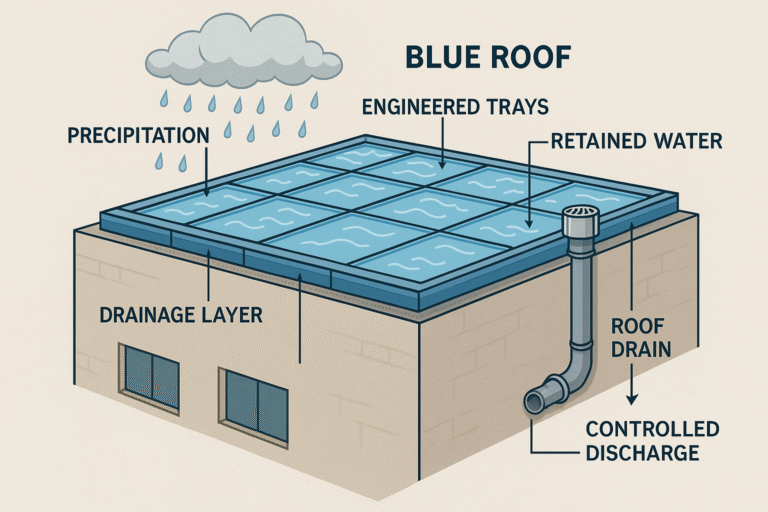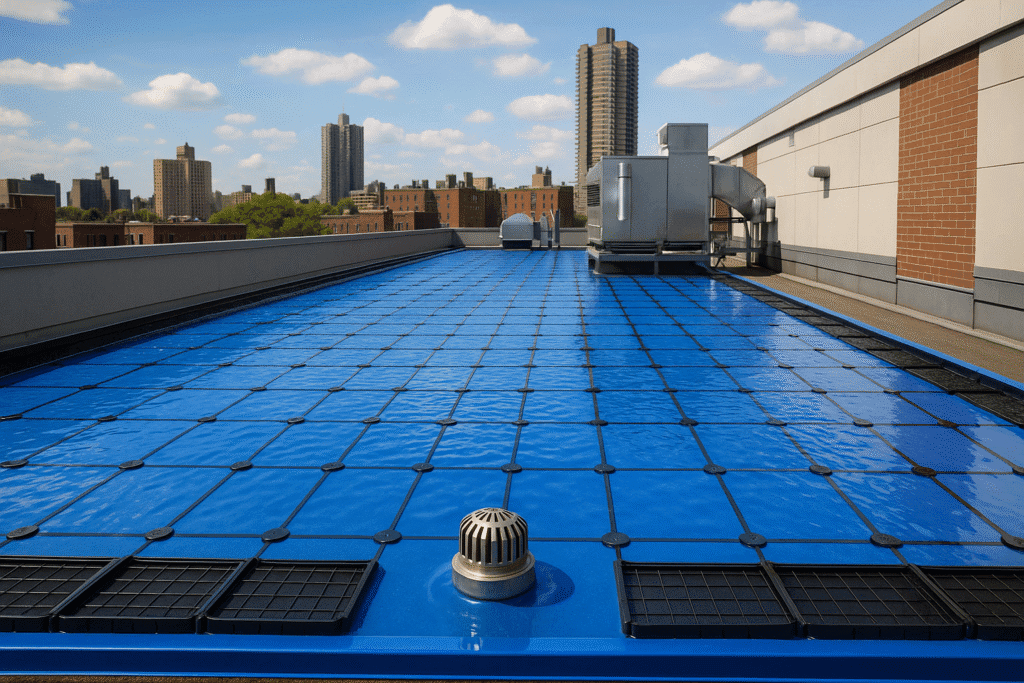
Table of Contents
ToggleWhat is blue roof ?
Blue roofs , unlike green roofs, which use plants and soil, blue roofs are designed to temporarily hold rainwater on flat rooftops. They a delay in releasing the water in the drainage system. This is simple and effective planning, especially in dense cities across the US, UK, or Canada.
As urban populations grow and climate change becomes more frequent, cities around the world are now focusing on managing excess rainwater more effectively because traditional stormwater systems are overwhelmed, which leads to flash floods. In this article, we will see the key blue roof benefits and blue roof stormwater management.
Top 10 Blue roof benefits
Blue roofs are not just a flood-preventing tool; they offer a lot of benefits for cities dealing with rapid urbanization, outdated infrastructure, and climate problems. Below I have mentioned 10 major blue roof benefits, representing it as a valuable part of sustainability.
1. Delay in stormwater runoff
This is the primary benefit, Blue roof temporarily stores rainwater and then releases it slowly over time. This delays peak discharge into storm drains which reduces the risk of street-level flooding, sewer backups and waterlogging during heavy rainfall events.
2. Reduces pressure on the urban drainage system
Blue roof lightens the immediate burden on aging sewer systems and treatment plants via staggering the release of rainwater directly into the drain. It is helpful in tier 1 old cities (London, newyork) which have a combined sewer system. According to the NYC Department of Environmental Protection, a blue roof can reduce peak stormwater flow by up to 80% during heavy rainfall.
3. Helps control combined sewer overflows
Nowadays, many cities use combined sewer systems where stormwater and wastewater share the same pipe. This stormwater can be treated, but when they are mixed, they cannot be treated. During storms, this untreated sewage overflows into rivers. A blue roof can delay and reduce inflow.
4. Lowers the risk of basement flooding
Those buildings that are made with Blue roofs experience less runoff spilling into surrounding areas. It creates a low chance for water to enter basements, parking garages, and street-level properties. New York City Blue Roof Pilot monitoring found that it can reduce peak stormwater flow by 30-85%.

5. Improves water quality
By slowing down runoff, sediments, debris, and pollutants can be easily trapped before they enter the natural water bodies. Some newly made systems can be combined with filters to clean stormwater before discharging it.
6. Support climate resilience
Nowadays, more intense rainfall events are being predicted; hence, urban blue roofs act as adaptive infrastructure. It will be scalable and effective in protecting dense cities from climate-driven water challenges.
7. Enhancing the performance of other infrastructures
When urban blue roofs are used with bioswales, rain garden or green roofs they perform better. Blue roof delivers water at a controlled rate, which prevents overload.
8. Provide temporary cooling effect
Detained rainwater can provide a mild cooling effect by evaporation. Water absorbs heat from its surroundings and evaporates, cooling down its surroundings. It is called latent heat of evaporation. It is beneficial during summer storms in heat-prone cities.
9. Allow for smart monitoring
Modern urban blue roofs can be equipped with sensors, valves, and weather-based automation, which makes them a part of the city’s smart water management network. Data from these systems can optimise performance during extreme weather.
10. Easy to retrofit on flat
Unlike green roofs, urban blue roofs require less structural reinforcement and can often be installed in existing rooftops with minimal modification. This makes them cost-effective for retrofits on office buildings, schools, and apartments.

Blue roof stormwater management
The speed and amount of rainwater hitting the storm drains are one of the biggest problems in modern cities. Conventional flat roofs typically channel the rainwater into gutters and sewers, which creates a surge of runoff that can lead to flooding or sewer overflow.
According to the U.S. EPA – Stormwater to Street Trees Guide, urban areas with traditional roofs and Pavements generate around 5 times more runoff than a natural landscape.
Blue roof system explained:
Blue roof stores rainwater temporarily on the rooftop surfaces by using specialized trays or controlled flow drains. Instead of rushing into the stormwater system at once, rainwater in the blue roof stormwater management is held back and released slowly over time. This process is also known as detention or flow moderation. This is done by using :
- Shallow detention trays or reducing those that sit beneath or on the roof surface
- Controlled floor drains that release water slowly over time.
Depending on the design Blue roof may include :
- Modular trays or tanks for holding water
- Adjustable roof drains or orifices to control outflow rate.
- Advanced blue roof stormwater management may also include Sensors or smart valves.
And through this blue roof can :-
- Reduce peak runoff volumes
- Delay the timing of runoff which prevents system overload
- Lower the risk of localised flooding
- Improve the performance of green infrastructure like bioswales and rain gardens.
These capabilities make blue roof valuable in dense cities where space is limited and even a small reduction in stormwater runoff can protect streets, basements, and public infrastructure.
Why blue roofs are important for urban areas
- A single Blue roof can delay the run-off by hours, giving the City’s storm water systems more time to process water.
- In a localised storm, multiple Blue Roofs can reduce peak runoff volume across a building, which helps to protect infrastructure downstream.
- It minimizes combined sewer overflows, especially in older cities like New York, London, and Chicago.
- It also pairs well with other green infrastructure like bioswales, green streets and rain gardens.

Limitations of urban blue roofs
Blue roofs require a rooftop to store water, which adds extra weight on the building, and not all existing buildings are capable of holding extra load, hence it creates a sense of collapse. Sometimes Blue roofs are not properly installed, which causes leakage issues, especially if the drainage is blocked. In some cases ponding water can remain too long.
In colder regions like Canada or UK standing water can freeze which creates ice loads and drainage blocking. To counter this issue, you can make sure that proper insulation, drainage design, and freeze-thaw-resistant materials are essential. Blue roof needs regular inspection and debris clearing. Hence neglecting maintenance can reduce performance.
According to U.S. General Services Administration (GSA) – Roof Asset Management Guidelines, structural retrofitting costs for blue roofs can range from $5 to $20 per square foot depending on the complexity.
FAQ
What is difference between blue roof and green roof ?
Urban Blue roofs are designed to temporarily store rainwater and then slowly release it into the drainage system. It helps to prevent overflooding and drainage system failure. On the other hand, green roofs support the whole biodiversity; they involve vegetation that absorbs rainwater and provides insulation. Blue roof stormwater management is different from green roof but both have their own benefits.
Are blue roofs sustainable for all buildings ?
Clearly No. Blue roof are installed during construction of the buildings or they are retrofitted, but under some conditions. The rooftop shoul be able to hold extra weights of rainwater and hence they are best for commercial industrial or multi-family buildings.
How much water can a blue roof manage ?
A well designed blue roof can 1 to 4 inches of water per rain event. The exact amount also depends on the system type and roof area. On an average it’s 25 – 100 mm of water.
Dp blue roofs required special permit ?
In many cities like New york or Chicago blue roofs should be in favour with buildings and local stormwater designs. So you should always consult with your municipality before installing it.
Conclusion
We know that cities are facing challenges due to rising rainfall intensity and urban flooding; hence, blue roof stormwater management becomes a practical, scalable, and cost-effective way to overcome this situation. We came across many blue roof benefits, whether it is installed or retrofitted, it will always be beneficial for tier 1 cities. As awareness among us grows, the possibility of blue roof stormwater management becoming a useful infrastructure also increases. Stay tuned with Ventrofy.
How to reuse old rain barrels during and after rainfall ?
